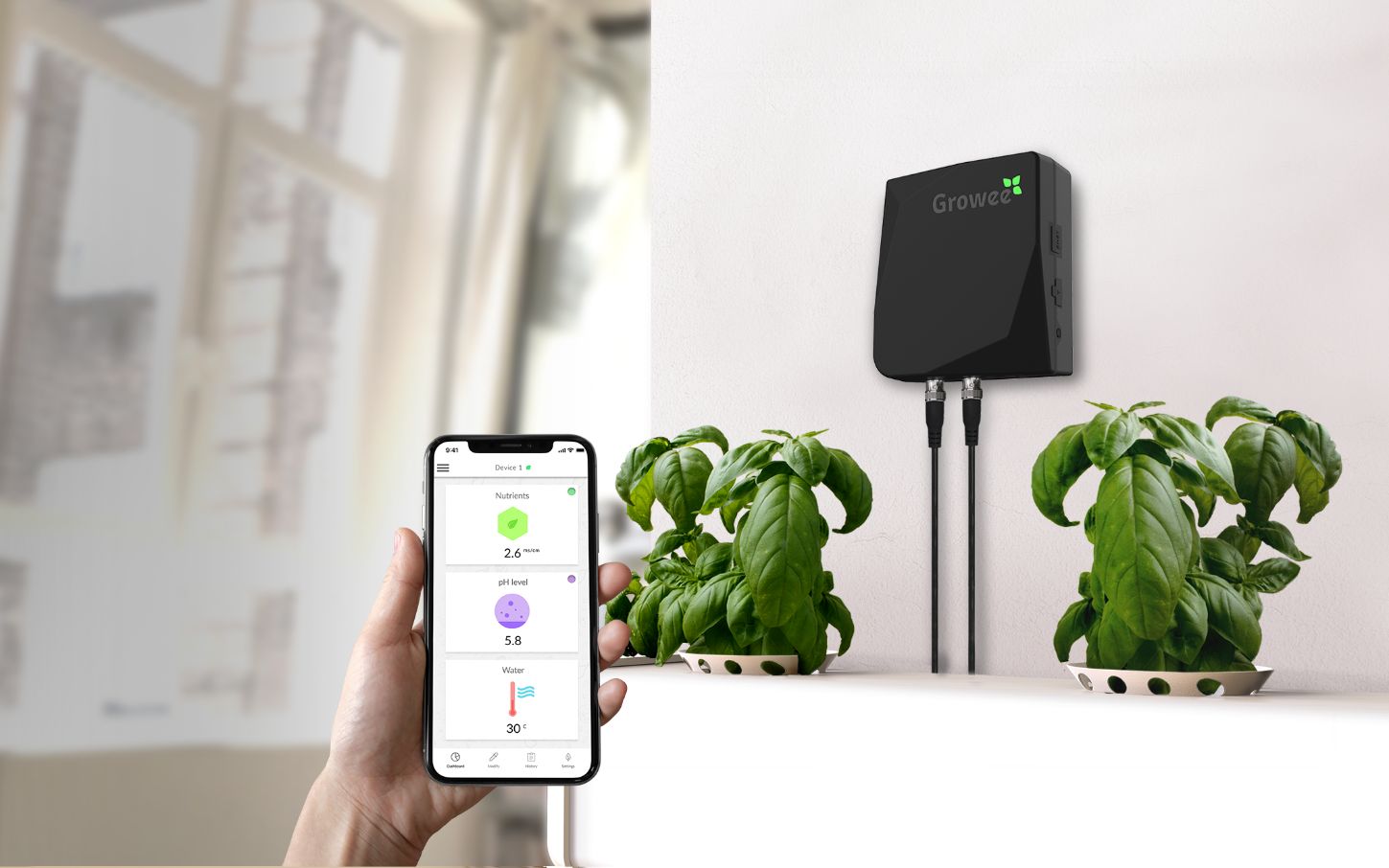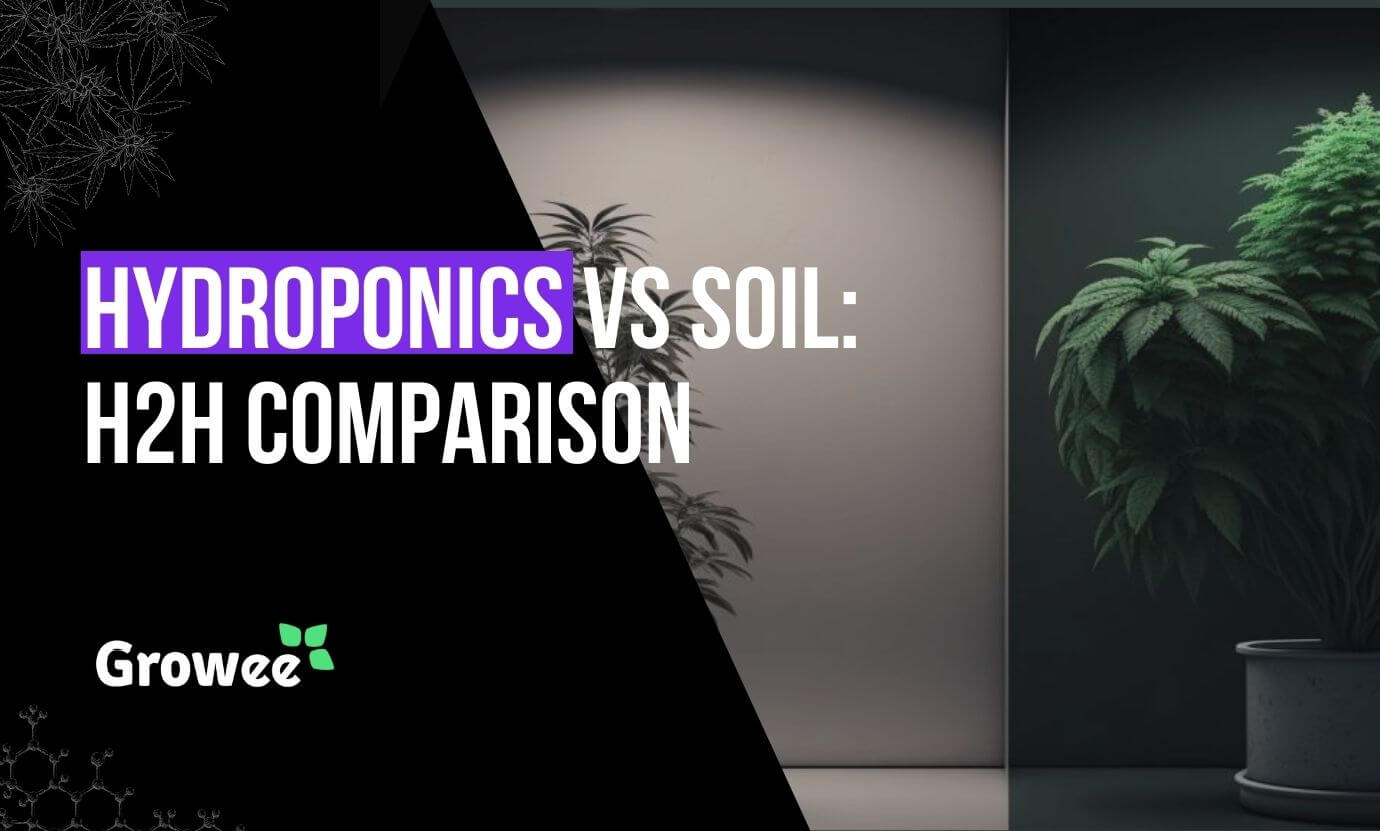In the world of cannabis cultivation, choosing the right growing method can significantly impact the quality, yield, and efficiency of your harvest. This comprehensive guide will delve into the intricacies of hydroponic and soil systems, exploring their nutritional differences, water requirements, yield potential, and associated costs.
See How Growee Can Save You Time By Automating Your Plants Feeding
Water pH – Automated pH Up and Down Control
Nutrients Mixing – Automated Nutrient Dosing with Target EC / PPM Control.
Control From Anywhere – WiFi Connection and mobile App
Comparing Nutrient Differences in Hydroponic vs. Soil Systems for Cannabis Growing
Both soil and hydroponic cannabis cultivation methods require a balanced blend of macro and micro-nutrients to help plants thrive. However, the delivery and management of these nutrients vary significantly between the two methods.
In hydroponics, growers must add all plant nutrients directly to the water. This process typically involves particular hydroponic nutrients, which often come at a higher cost than soil amendments or fertilizers used in traditional soil-based cultivation.
Creating a nutrient solution for a hydroponic system can be a meticulous task, particularly when growing cannabis in later growth stages. Mixing up to 10 different components might be necessary. This step also involves careful monitoring of the electrical conductivity (EC) to prevent the solution from becoming too concentrated or diluted. Maintaining an optimal pH balance is also crucial to ensure maximum nutrient uptake; pH levels that are too high or low can restrict certain nutrients.
A significant advantage of hydroponics is the level of control it allows over plant feeding. Growers can adjust and optimize the nutrient solution to suit the specific needs of their plants at each growth stage, promoting plant health and potentially enhancing yield and quality.
Although this high level of control can potentially result in larger yields and faster growth compared to soil cultivation, it demands close attention and frequent adjustments from the grower. Regular checks are necessary to ensure that the nutrient solution stays within the optimal range for cannabis growth, which is generally an EC of 0.6 to 3.5 mS/cm and a pH of 5.5 to 6.5.
On the other hand, soil cultivation usually delivers nutrients via the soil and additional fertilizers. Overwatering can be an issue, but the risk of nutrient burn or deficiencies tends to be lower, making it a more forgiving method for beginners. The soil serves as a buffer and can be further enriched with nutrient blends for optimal plant growth

Water Requirements: Hydroponics vs. Soil in Cannabis Cultivation
In hydroponic systems, water is a necessity and the primary medium for nutrient delivery. The constant contact between the plants and the water allows them to uptake what they need without the risk of drying out. However, this requires careful management to prevent problems like root rot, which can occur if the roots are constantly waterlogged and oxygen-starved.
The quality of water used in hydroponics is of utmost importance. Situations with high Electrical Conductivity (EC) or high levels of contaminants like chloride demand particular attention as they can harm the plants. In such cases, growers should consider mixing their water source with Reverse Osmosis (RO) water. Despite the initial investment, an RO system ensures the water is purified and free from contaminants, thereby preventing water contamination and ensuring healthier plant growth.
Moreover, hydroponic systems often use less water than soil-based systems because they recirculate the water, making hydroponics an excellent choice for water conservation.
In contrast, soil-based systems require meticulous watering to maintain the right moisture levels. Overwatering is a common mistake in soil growing, leading to waterlogged soil and potentially causing root problems like rotting or fungal diseases. Conversely, underwatering can result in plants drying out. The watering needs in soil cultivation depend on factors like the size of the plant, pot size, temperature, humidity, and the soil’s water retention capacity.
While hydroponics might be more water-efficient, it requires more precise water management. Soil growing may require more water but is often considered easier to manage for new growers.
Hydroponic Cannabis vs. Soil-Grown Cannabis: Which Yields More?
Hydroponic systems typically facilitate faster plant growth and produce larger yields than soil-based systems. This accelerated growth cycle is primarily due to the superior control over nutrient delivery in hydroponics. The direct access to nutrients eliminates the need for the plants to expend energy on extensive root growth to seek out nutrients as they would in soil. Additionally, the controlled environment can result in more yearly harvest cycles than traditional soil cultivation, boosting the overall yield.
However, while hydroponics can deliver remarkable yields and quicker growth cycles, it requires meticulous monitoring and management. The risk of encountering issues such as root diseases, pests, and system failures could pose a significant threat to the entire crop if not appropriately handled. Therefore, the success of a hydroponic system, in terms of yield, largely hinges on the skills and attentiveness of the grower.
In contrast, soil-grown cannabis might yield less on a plant-by-plant basis compared to hydroponics and have a slower growth rate, but many growers find soil to be more forgiving and easier to work with. The soil acts as a buffer for nutrients, protecting the plants from a nutrient burn, and it houses beneficial microbes that enhance nutrient uptake and provide defense against root diseases.
So, while hydroponics might hold the upper hand regarding potential yield quantity and growth speed, soil cultivation has unique advantages. It remains a preferred choice for many, especially organic growers and beginners. As with any cultivation method, the final yield also depends on factors like seed or clone quality, adequate lighting, and proper plant care throughout the growth cycle.

Cost, Time, and Effort Considerations When Choosing Between Soil and Hydroponic Systems
- Initial Setup Cost: Soil-based growing generally costs less upfront than hydroponics. With hydroponics, you must invest in a growing system, grow lights, nutrient solutions, pH testers, and other necessary supplies.
- Running Costs: Soil growing has lower running costs, as you primarily need to invest in soil, seeds, water, and additional nutrients occasionally. On the other hand, hydroponic systems will require consistent purchases of nutrient solutions, replacement of parts like pumps and lights, and the ongoing cost of electricity to run the system.
- Time and Effort: Hydroponics can be more labor-intensive, especially in the beginning stages. Regular monitoring and adjusting of nutrient levels and pH are crucial. However, once you are familiar with the system, it can save time due to faster growth rates and automated systems like Growee, which handle most of the monitoring tasks. While less technical, soil growing requires regular attention for watering, pest control, and maintaining soil health.
- Yield: While soil growing can produce high-quality cannabis, hydroponics often leads to higher yields due to the controlled environment and constant access to nutrients. This can make hydroponics more cost-effective in the long run if you plan on large-scale or commercial production.
- Skill Level: If you’re a beginner, soil growing can be more forgiving and easier to manage. Hydroponics usually appeals more to experienced growers or those willing to invest time into learning the system and managing it meticulously.
Ultimately, the choice between hydroponics and soil should be based on your budget, time availability, harvest goals, and personal preference. It’s also worth considering that advancements in technology are reducing the cost and effort required for hydroponic growing, making it an increasingly economical choice for many growers.
Challenges Faced When Upgrading from Soil to Hydroponics in Cannabis Cultivation
- Earning Curve: Transitioning from soil to hydroponics involves understanding new techniques, systems, and equipment. This includes learning about nutrient solutions, pH balancing, and water circulation systems.
- Increased Monitoring: Hydroponic systems require consistent monitoring and adjustment of nutrient levels and pH. This can be time-consuming and demands a more hands-on approach than soil growing.
- Initial Cost: Setting up a hydroponic system usually requires a larger upfront investment than soil-based growing. Costs include purchasing or building the system, buying nutrient solutions, pH testers, and other necessary supplies.
- Risk of System Failure: Hydroponic systems, especially automated ones, can suffer from technical failures like pump or power failures, which can be devastating if not immediately addressed.
- Disease Spread: Diseases or pests in hydroponic systems can spread quickly due to water recirculation. This necessitates rapid response to any sign of disease or pest infestation.
- Change in Routine: Growers accustomed to soil may find it challenging to adapt to hydroponic cultivation’s different routines and schedules.
- Space Considerations: Hydroponic systems, particularly those designed for larger yields, can take up significant space, which may not be feasible for all growers.
The decision to upgrade from soil to hydroponics should be made after careful consideration of these challenges, as well as the potential benefits. Some growers may find that the increased control and potential for higher yields in hydroponics are worth the investment of time and resources. Others may prefer the simplicity and natural approach of soil cultivation
Overcoming the Challenges of Upgrading from Soil to Hydroponics with Growee
- Simplifying the Learning Curve: The Growee system simplifies the transition from soil to hydroponics by offering user-friendly and intuitive software. It helps growers manage and monitor their hydroponic systems more effectively, reducing the complexity typically associated with hydroponic cultivation.
- Automated Monitoring: Growee’s platform provides automated monitoring of your hydroponic system. It continuously tracks and adjusts nutrient levels and pH, reducing the manual labor and time investment required to maintain optimal growing conditions.
- Minimizing Risk of System Failure: Growee’s system offers real-time sensor reading with full pH and EC automation. This feature helps growers mitigate risks and take prompt corrective action, thus protecting their crops.
- Early Disease Detection: With Growee’s smart monitoring system, any anomalies that may indicate disease or pest infestation are detected early. This allows growers to act swiftly and prevent the spread of disease, minimizing potential damage.
- Scalable Solutions: Whether you are a small-scale home grower or a commercial cultivator, Growee’s solutions are scalable to meet your space and yield requirements.
Transitioning from soil to hydroponics is made easier with Growee’s smart, automated solutions, effectively addressing many of the typical challenges faced by growers when making this upgrade.
Final Words
The process of cultivating cannabis, whether it’s in soil or a hydroponic system, brings its unique set of challenges and rewards. As a grower, the choice ultimately depends on your cultivation goals, available resources, and your readiness to explore and adapt to new techniques. Embracing technological advancements like Growee can significantly streamline the process, making hydroponics more accessible, manageable, and profitable. As you continue your cultivation journey, remember that every decision you make impacts your plants and the quality of your final product. Choose wisely, and happy growing!



